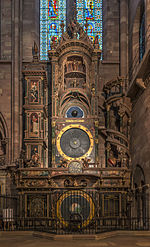Sainte-Madeleine, Strasbourg
20th-century Roman Catholic church buildings in FranceArt Nouveau architecture in StrasbourgArt Nouveau church buildings in FranceGothic architecture in StrasbourgMonuments historiques of Strasbourg ... and 2 more
Roman Catholic churches completed in 1907Roman Catholic churches in Strasbourg

The Sainte-Madeleine Church (Église Sainte-Madeleine, German: Magdalenenkirche) is a Catholic church in Strasbourg, France, which was built in Gothic style in the late 15th century, but largely rebuilt in a style close to Jugendstil after a devastating fire in 1904. Destroyed again during World War II, the church was re-constructed in its modern form. This is the fourth building dedicated to Mary Magdalene built in the city since the 13th century. The church is classified as a historic monument by a decree of 6 December 1898.
Excerpt from the Wikipedia article Sainte-Madeleine, Strasbourg (License: CC BY-SA 3.0, Authors, Images).Sainte-Madeleine, Strasbourg
Place Sainte-Madeleine, Strasbourg Krutenau
Geographical coordinates (GPS) Address External links Nearby Places Show on map
Geographical coordinates (GPS)
| Latitude | Longitude |
|---|---|
| N 48.58 ° | E 7.7547222222222 ° |
Address
Église catholique Sainte-Madeleine
Place Sainte-Madeleine
67085 Strasbourg, Krutenau
Grand Est, France
Open on Google Maps











